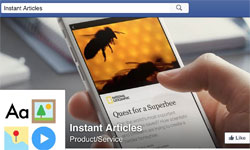My read on Facebook’s deal with nine news publishers to post some material direct to the platform: yes, it’s a significant business development but by no means apocalyptic, as some commentators are suggesting.
Here’s why:
Good company: It was artful of Facebook and the publishers to assemble nine prominent brands to launch the experiment — including new media exemplar BuzzFeed, magazine-based National Geographic and four international titles.
Were this just The New York Times, for instance, one would wonder whether the opportunity and deal terms were a one-off match to their business situation. Not so with this roster.
Favorable revenue split: The publishers will (for now at least) get 100 percent of revenue for ads they sell and 70 percent of those Facebook sells. It is a good sign that Facebook did not try to exercise leverage to keep more of the money.
Ditto the data: Without being terribly specific, the deal makers are also saying Facebook will be sharing some analytics on users with participating publishers.
Critics of the arrangement fear that a publisher sharing data on its customers with the digital behemoth is giving away the store (or at least several aisles of it). Sure, digital transformation, especially as a business proposition, entails an arms race to gather and and analyze much more data about users, then use that to serve tailored content and ads.
But the notion that publishers should hoard these “crown jewels” and beat Facebook and Google at their game seems to me more bravado than sound strategy. I have been hearing for years that Google and Facebook are light years ahead in the volume of data gathered and its sophisticated use — hence their enormous and growing share of digital advertising, especially the rocketing mobile portion.
Plus, the big platform companies have the capital and R & D culture to stay ahead.
Win-win. Any deal between wary competitors needs to provide mutual benefits. The publishers get exposure to a wider audience. Facebook users, so inclined, get a broader range of quality news content.
But I also think there is a hidden benefit to Facebook. The status quo has included frequent revisions of the news recommendation algorithm. Those may be frustrating to publishers, but they also put Facebook playing out of position as a news arbiter.
So much better to enter a collaborative era with publishers who do have that expertise.
The big train has left the station. Yes, publishing on your own site has benefits and remains a powerful tradition in the news business. But it has been axiomatic for most of this decade that much, maybe most traffic now comes through side-doors rather than to a branded home-page or article display.
Facebook long passed Twitter and has just pulled ahead of Google as the entry-way for that traffic. So what exactly is the logic of still treating the proprietary site as a walled content garden? Dealing with how contemporary audiences get to news makes all kind of sense.
Starting small. A savvy deal-making business friend liked to invoke the arms negotiations concept of “confidence building” in this sort of situation.
Right now, the news outlets are making only a limited number of articles available for direct post. That allows time to figure out which content works best on the Facebook platform, whether to publish a much bigger share of digital stories there and to scope out unexpected snags in the initial business arrangement.
What’s so instant about “instant articles”? I was baffled at first why the deal launched under the banner of “instant articles.”
In its pithy three paragraph announcement to users, Facebook makes very clear what it means by instant — quick load time.
Web articles in the Facebook app take an average of eight seconds to load, by far the slowest single content type on Facebook. Using the same technology that loads photos and videos quickly in our mobile app, Instant Articles load as much as ten times faster than standard mobile web articles, so you get to the stories you want to read instantly. Once there, new features like tilt-to-pan photos, auto-play video, embedded audio captions, and interactive maps let you explore the story in beautiful new ways.
That’s a benefit to current Facebook news users and potential ones. It is also a response to the “three-second” challenge digital futurist Amy Webb posed to newspaper publishers at their annual conference this spring. If, as research has shown, smart phone users decide within three-seconds whether to continue engagement with what’s on the screen, how do news publishers adapt?
Part of the answer has to be be getting the post to display instantly — or almost.
All that said, I am not dismissive of those who see danger ahead. Facebook does what’s best for Facebook’s business. It is not a patron of the journalistic arts. Some leading publishers — the Wall Street Journal is signaling reservations — may see more downside than up for their particular circumstance.
Still, for this particular deal, I think the participating publishers are mostly ratifying reality, not placing a reckless futures bet.









Comments